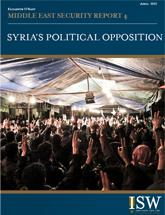 |
 |
Syria's Political Opposition

Executive Summary
- Policymakers must identify and understand Syria’s political opposition, both in exile and on the ground, in order to develop a clear vision of their aims and a better strategy for support. Any successful U.S. policy in Syria should focus on constructing a viable alternative to Assad’s government.
- This report provides detailed information on the diverse groupings of the Syrian political opposition in order to inform the international community’s response to the conflict. It distinguishes between the expatriate political opposition and the grassroots protest movement operating on the ground in Syria.
- Policymakers must come to the understanding that they may not get the chance to sit across the table from a single opposition party, but rather will have to work directly with the nascent political-military structures that have formed at a local level.
- The key to creating an effective national opposition lies in connecting the established national coalitions with the grassroots political movement.
- The most well-known and widely recognized established political opposition coalition is the Syrian National Council (SNC). The SNC is based in Istanbul and functions as a loosely-aligned umbrella organization comprised of seven different blocs: the Muslim Brotherhood, the Damascus Declaration, the National Bloc, the Local Coordination Committee (as representatives of the grassroots movement), the Kurdish Bloc, the Assyrian Bloc, and Independents.
- The SNC has not meaningfully engaged with local opposition forces, and is losing credibility and influence within Syria as the conflict grows more militarized.
- The other significant established political opposition coalition is the National Coordination Committee (NCC). The NCC is based in Damascus and favors a negotiated political settlement and dialogue with the regime. This stance has made the NCC less popular amongst the grassroots opposition movement.
- The grassroots movement functions at a local and regional level through coordination between the local coordinating committees and revolutionary councils. This movement has become tactically adept, better organized, and more cohesive, developing nascent political structures.
- The local coordinating committees, called the tansiqiyyat, form the base unit of organization. As the movement has grown, urban centers have developed oversight councils called the revolutionary councils to manage the committees within specific districts.
- The revolutionary councils are the main organizational structure for the grassroots political opposition. They manage the activities of the tansiqiyyat, organize protests, and coordinate with the armed opposition.
- The Syrian Revolution General Commission (SRGC) is the largest grassroots coalition. It represents roughly seventy percent of the revolutionary councils and the majority of the local coordinating committees.
- The armed opposition cooperates with the grassroots political opposition and a number of insurgent groups have shown a willingness to work under the guidance of the revolutionary councils.
- The lack of secure communications equipment has hindered the grassroots opposition’s ability to coordinate above the local level because the government retains the overwhelming capacity to monitor, track and suppress greater organization at a national level.
- The established political coalitions such as the SNC have articulated a national vision for a post-Assad future and have received nominal support from the international community, yet they lack strong networks and popular legitimacy inside Syria. On the other hand, the grassroots political opposition has gained the support of the people, but it lacks a national vision and united front as the basis for international support.
- The United States must consider adopting a bottom-up strategy that provides better support to the grassroots movement operating within Syria. This entails developing better relations with critical elements of the grassroots movement and working with key individuals who have deep networks of supporters within Syria but also maintain ties to the SNC or the NCC.
- A bottom-up strategy would provide an avenue for U.S. support that incorporates both national and local opposition groups and encourages the emergence of a legitimate national political leadership.